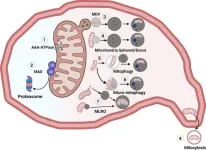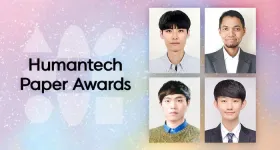(Press-News.org)
A new study suggests that delta-8-THC, an intoxicating substance typically made from hemp, is being used by a substantial number of young people across the United States and could potentially pose a significant public health risk.
Delta-8-THC products, which include gummies and vapes, look like marijuana products and have similar mood-altering effects. Delta-8 is often manufactured out of cannabidiol from hemp rather than marijuana, and there is no federal minimum age requirement to purchase delta-8 products. In various states, delta-8-THC is widely sold at gas stations or online, but rates of use among American youth have been unknown.
Now, researchers from the Keck School of Medicine of USC, in collaboration with the University of Michigan and with support from the National Institute on Drug Abuse, have analyzed survey responses from more than 2,000 randomly selected U.S. 12th graders about their delta-8-THC use during 2023. Data came from students in the Monitoring the Future survey, the nation’s leading source for tracking drug use in American youth. The researchers found that 11.4% of 12th graders used delta-8-THC in the past year. Rates of delta-8-THC use were even higher in Southern and Midwestern states, as well as states that lacked their own delta-8-THC regulations or had not legalized adult (“recreational”) marijuana use. The results were just published in JAMA.
“Considering that delta-8-THC has only been on the market since 2018, the fact that we’re seeing more than 11% of youth using it is concerning,” said Alyssa F. Harlow, PhD, MPH, a clinical assistant professor in the department of population and public health sciences at the Keck School of Medicine, a member of the USC Institute for Addiction Science (USC IAS) and the study’s lead author. “It’s evidence that we should be paying attention to these products, particularly in the areas where we saw even higher prevalence.”
Because delta-8-THC is so new, its public health impact is unknown. Given the substance’s chemical similarities with delta-9-THC, the primary psychoactive component in marijuana, scientists are concerned that delta-8-THC could pose similar health risks to marijuana, including effects on brain development, addiction, behavioral problems and accidental overdose. Delta-8-THC is unregulated in many states, meaning there are few safeguards to prevent impurities and toxic compounds and no requirements for warning labels and ingredient listing. A lack of restrictions means that delta-8-THC can also be packaged and marketed in ways that appeal specifically to youth.
“Time and time again, we see the same pattern. When a new addictive drug hits the market and is commercialized, youth are the first to be affected if public health protections are not in place. We saw this with nicotine e-cigarettes and should not let history repeat itself with delta-8-THC or the other hemp products,” said the paper’s senior author, Adam Matthew Leventhal, PhD, a professor in the department of population and public health sciences at the Keck School of Medicine and executive director of USC IAS.
Tracking nationwide use
The Keck School of Medicine team has been a driving force behind the public health research on delta-8-THC, sounding the alarm on its risks and leading efforts to study rates of use among youth.
“Until now, there were no studies that estimated how common delta-8-THC use is in a nationally representative sample,” Harlow said.
In 2023, 2,186 U.S. 12th graders who completed the Monitoring the Future survey answered questions about their delta-8-THC use. Monitoring the Future is a rigorous classroom-based survey that is considered a gold standard for tracking youth substance use. It includes students from every region of the country whose answers are weighted so that they accurately represent the gender, race and parental education levels of the U.S. population.
Of those surveyed, 11.4% of 12th graders reported using delta-8-THC in the past year and 30.4% reported using marijuana. Among those who had used delta-8-THC in the past year, 35.4% used it 10 or more times.
In Western states, 5% of youth used delta-8-THC, compared to 10.1% in Northeastern states, 14.3% in Southern states and 14.6% in Midwestern states. In states where delta-8-THC was regulated, 5.7% of youth used the products, compared to 14.4% in states without regulations. Eight percent used delta-8-THC in states where adult marijuana use was legal, compared to 14% in states where adult marijuana use was banned.
Regulations to reduce risk
The findings provide early evidence that regulating delta-8-THC might help lower use among youth, Harlow said. While some states have completely banned the substance, restricting delta-8-THC products is also an option. Policies could include packaging and labeling requirements, a minimum purchasing age, restrictions on where delta-8-THC can be sold, or required testing of products for contaminants.
The present study was an initial pulse check on delta-8-THC use, but more research is needed. The 2024 Monitoring the Future survey will include additional questions on the new products, including what form youth are using (such as gummies, vape cartridges or dried flower) and where they are purchasing it. Over time, longitudinal data will also help show which policy changes are effective for mitigating risk.
Harlow is also studying whether rules for delta-8-THC packaging—for example, the inclusion of cannabis warning labels—can change youth perceptions of how risky the products are.
About this research
In addition to Harlow and Leventhal, the study’s other author is Richard Miech from the Institute for Social Research, University of Michigan.
This work is supported by the National Institute on Drug Abuse [K01DA058084, K24DA048160, R01DA001411]. The content is solely the responsibility of the authors and does not necessarily represent the official views of the National Institutes of Health.
END
The pandemic put a spotlight on the challenges that health systems face when deciding how to allocate scarce resources during a time of crisis. To better understand differing opinions on this issue, researchers at the David Geffen School of Medicine at UCLA and UC Health conducted a survey of laypeople and healthcare professionals, and found that while both groups have similar priorities for allocating medical resources, they are less aligned on how these priorities should be achieved.
“We did this study in response to concerns in the pandemic that we could run out of critical resources, such as mechanical ventilators, and that health systems ...
WASHINGTON, DC – The Editorial Board of the Proceedings of the National Academy of Sciences (PNAS) has selected six papers published by PNAS in 2023 to receive the Cozzarelli Prize, an award that recognizes outstanding contributions to the scientific disciplines represented by the National Academy of Sciences (NAS). Papers were chosen from more than 3,000 research articles that appeared in the journal last year and represent the six broadly defined classes under which the NAS is organized. Additionally, the Editorial Board has recognized ...
Washington, D.C. (March 12, 2024) — The Association for Psychological Science, the leading global organization dedicated to advancing scientific psychology for the benefit of science and society, is revamping its roster of regularly scheduled events to better foster global scientific collaboration and environmental sustainability.
Starting in 2025, APS will merge its Annual Convention and the biennial International Convention of Psychological Science (ICPS). The new APS Annual Convention will rotate outside of North America ...
Watch the video announcement here.
New York, NY (March 12, 2024) – The Icahn School of Medicine at Mount Sinai, fulfilling its commitment to connecting medical care with public health, today established a new Department of Public Health under the visionary leadership of Rosalind J. Wright, MD, MPH, the Horace W. Goldsmith Professor in Children’s Health Research at Icahn Mount Sinai.
The Department of Public Health will bridge the school’s existing excellence in environmental medicine, population health, global health, infectious disease, climate science, digital health, data science and artificial intelligence, community engagement, ...
A new study co-authored by a University of Massachusetts Amherst economist reveals the value of government vaccine recommendations to drugmakers, as well as potential benefits of advertising pharmaceuticals directly to consumers — a practice that is banned in every country apart from the United States and New Zealand. The research is the most comprehensive investigation to date of manufacturer marketing and consumer response to adult vaccine recommendations.
After the U.S. Advisory Committee on Immunization Practices (ACIP) recommended in 2014 that people aged 65 and over receive the pneumococcal vaccine Prevnar 13, Medicare and private ...
A team of Medical University of South Carolina researchers, led by Onder Albayram, Ph.D., reports in PNAS Nexus that they have discovered a novel protective response by which the brain naturally repairs itself after traumatic brain injury. Findings could lead to drug treatments that improve the brain’s ability to recover after concussions and prevent long-term brain disease.
“Brain recovery mechanisms are very, very powerful,” said Albayram. “We don’t always have to develop new treatment approaches. We can also just give the brain a chance to heal itself properly.”
Repetitive mild ...
A new study finds that policies to reduce carbon dioxide (CO2) emissions from motor vehicles combined with investments in electric vehicles and public transportation would reduce air pollution and bring large benefits to children’s health. They would also save money.
The findings by researchers at Columbia University Mailman School of Public Health with collaborators at the University of California, Los Angeles, the University of North Carolina at Chapel Hill, and the Boston University School of Public Health appear in the journal Environmental Research ...
A new analysis of 5.8 million Americans finds that earning a college degree is still a sound investment, although the rate of economic return varies across college majors and student demographics. The findings come as skepticism continues to grow over the value of a degree in the face of rising college costs, a decline in college enrollment, and a transforming economy.
The study was published today in American Educational Research Journal, a peer-reviewed journal of the American Educational Research Association. It was conducted by Liang Zhang from New York University, Xiangmin Liu from Rutgers University, and Yitong Hu from New York University.
The study estimated ...
Scientists have identified a new organelle in liver cells called the mitochondria-lysosome-related organelle (MLRO). This discovery could improve our understanding of chronic liver diseases like alcohol-associated liver disease (ALD) and metabolic dysfunction-associated fatty liver disease (MAFLD).
Mitochondria are essential components of cells, often called the "powerhouses" because they generate energy. They also play a crucial role in metabolism, calcium signalling, and cell survival. When mitochondria malfunction, it's linked to various liver diseases.
Cells have intricate mechanisms to maintain healthy mitochondria. One way is to ...
Four exceptional UNIST students were honored for their outstanding academic and research achievements at the prestigious 30th Annual Samsung Humantech Paper Award ceremony.
Among the many eminent individuals, JungSoo Lee (Advisor: Professor Han Gi Chae) from the Department of Materials Science and Engineering notched the highest score and won the Gold Prize within the category of Energy & Environment. His groundbreaking research on enhancing the efficiency of thermoelectric power generation through the development of a new power generation device structure technology earned him this accolade. By focusing on optimizing the structure ...




